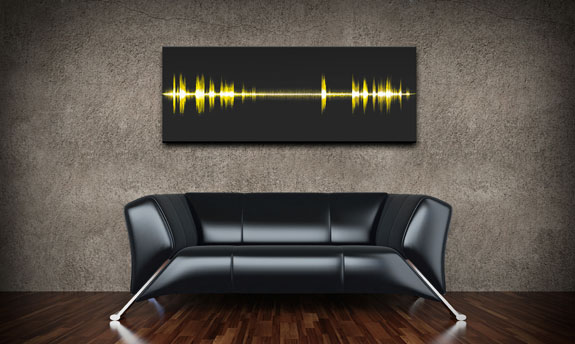Turn Your Favorite Words of Wisdom into Beautiful Art
A new company called Epic Frequency turns historic audio files into artwork
![]()

This Epic Frequency print captures the famous line from John F. Kennedy’s inaugural address on January 20, 1961: “Ask not what your country can do for you—ask what you can do for your country.” Courtesy of Epic Frequency.
If public speaking is an art form, then presidential elections produce some masterpieces—from memorable speeches and powerful sound bites to well-timed digs in the debates.
But Bill Seaver and Nathan Moore, two innovators from Nashville, have taken this idea to the next level. Their new company, Epic Frequency, takes the aural high points in history and actually transforms them into visual showpieces for your home.
According to the company’s Web site, the idea came to the co-founders one evening four years ago when they were recording their monthly podcast on new media and technology. (Seaver is a social marketing consultant, and Moore is a web developer.) It struck the two of them that the jagged waveform of an audio file in recording software is quite eye-catching. Why not select some of the most significant speeches and audio clips in history, they thought, and print the waveforms in bright colors on large black canvasses?

Martin Luther King, Jr. “I Have a Dream,” an Epic Frequency print based on the civil rights leader’s famous speech delivered from the steps of the Lincoln Memorial on August 28, 1963. Courtesy of Epic Frequency.
Epic Frequency launched just last week with nine initial offerings. The works of art include Neil Armstrong’s “One Small Step,” Ronald Reagan’s “Tear Down This Wall,” Franklin Delano Roosevelt’s “Fear Itself,” John F. Kennedy’s “Ask Not,” Martin Luther King, Jr.’s “I Have a Dream,” Albert Einstein’s explanation of “E=MC2,” President Barack Obama’s 2009 inauguration speech and, not to ignore this election season, both Mitt Romney and President Obama‘s convention speeches.
The criteria for choosing clips, says Moore, is “reflected in our name.” The speeches have to be epic. “Every audio recording that we select must have played an important role in our history. Usually these are moments that truly defined that era. They are glimpses into our past that changed the way we looked at the world,” he says.
On the side of each canvas is a QR code. A viewer can scan the barcode with their cell phone to access a mobile version of the print, with the actual audio overlaid on it. This way, one can listen to the speech and follow along with the peaks and valleys of the waveform. The company will sell 5,000 prints of an iconic speech, before retiring that particular design.
Clearly, Epic Frequency bridges art and history. But, of course, I am especially interested in how the concept combines art and science. What can these works teach people about sound? The artwork itself is data. So, what can viewers gather from it?
“We have continually been fascinated by the information that can be uncovered by analyzing the waveforms,” says Moore. “Since the sound amplitude is represented, volume and cadence become immediately apparent.” Seaver told Wired that he thought President Obama might have a speaking style similar to that of Martin Luther King, Jr., based on a visual comparison of their speeches.
The co-founders have their artistic preferences. They tend to think that the shorter the recording, the more visually appealing it is, because the sounds and silences are more pronounced in the waveforms. When looking at the “One Small Step” print, says Moore, you can almost hear Armstrong’s words, “That’s one small step for man, one giant leap for mankind,” uttered on July 21, 1969.
Epic Frequency is even venturing into personal histories, creating custom prints based on audio clips that customers provide. “We have definitely had some interesting requests,” says Moore. “Most are romantic or sentimental in nature, such as ‘I Love You,’ wedding vows or a baby’s first cry.”
/https://tf-cmsv2-smithsonianmag-media.s3.amazonaws.com/accounts/headshot/megan.png)

/https://tf-cmsv2-smithsonianmag-media.s3.amazonaws.com/accounts/headshot/megan.png)